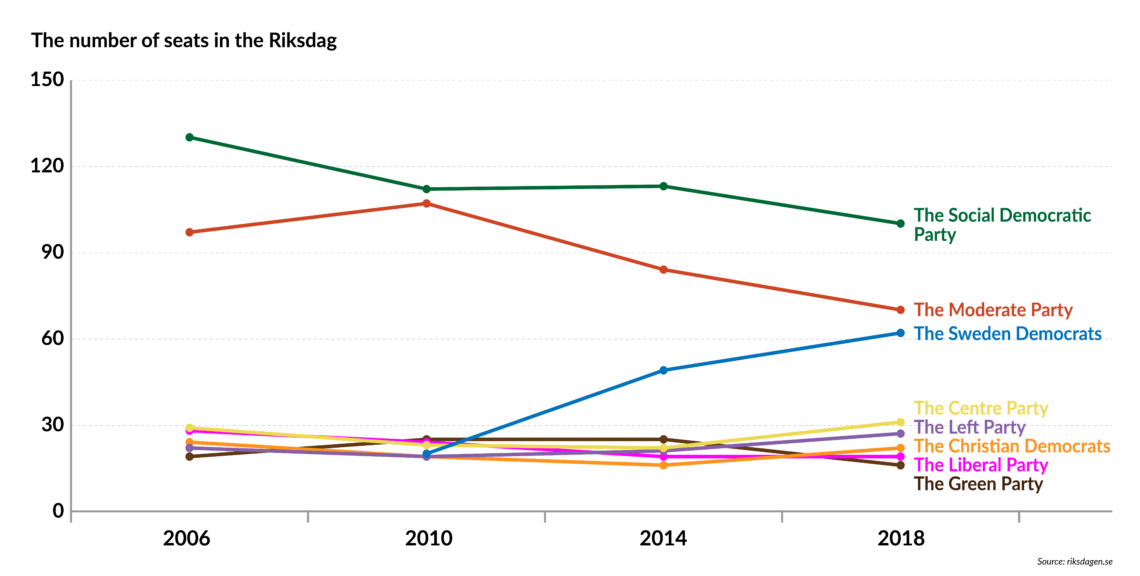Sweden is inching toward political transformation
Sweden may be nearing a political realignment. The center-left Social Democrats can no longer deny numerous problems which affect the country. The future of the party’s alliance with blue-collar labor unions is also uncertain. The party’s conservative nemesis, Sweden Democrats, has gained strength and may win in the 2022 elections.

In a nutshell
- Opinion polls in Sweden indicate that a major political change looms on the horizon
- Cooperation between the Social Democrats and labor unions no longer cements the country’s political scene
- Conservative Sweden Democrats have enough strength to act as kingmaker between the left and the right
The Swedish political system is nearing a critical crossroads. Recent tectonic shifts in opinion polls suggest that in the next general election in September 2022, the country’s political landscape may be fundamentally reconstituted. The transformation could entail an end to the century-long hegemony of the Swedish Social Democratic Party (referred to as SAP, or Social Democrats) and the dawn of an era dominated by the much-reviled national conservatives (SD).
Such an outcome would be akin to the Alternative for Germany (AfG) emerging as the dominant political force in the German Bundestag, with the Social Democrats (SPD), relegated to the third rank. This said, it does remain possible that the entrenched elites will prove deft enough to preserve the existing political order.
The current situation is so fluid – and filled with recriminations over who is to blame for a host of alarming trends in Swedish society – that it is hard to tell which way things will go. One thing, though, is sure: the shifts manifesting themselves in opinion polls will have a profound impact on the political game between now and September 2022.
Iron hold on power
Since World War II, the Social Democrats have been by far the most influential force in Swedish politics. In minority government most of the time, and out of government only during short periods, they have dominated the political agenda.
Under the formula of ‘union-political cooperation,’ unions have contributed substantial campaign funds and mobilized members to canvass in elections.
When four nonsocialist parties, self-styled as “The Alliance,” won the national election in 2006 and proceeded to rule for eight years, the key to their success was stealing much of the agenda of the Social Democrats. Back then, having long been in fundamental opposition to social democracy, the liberal-conservative Moderate Party came out suddenly in favor of the Swedish labor market model of collective bargaining and offering tax breaks for low-income earners, turning a cold shoulder to national defense, and adopting a positive attitude to migration. It worked like a charm. By 2014, however, their coalition government had run out of ideas and could be roundly defeated.
There is an important reason why the Swedish Social Democrats have managed to hold their ground, compared to social democratic parties in so many other European countries. It lies in the long-standing fusion of interests between the party and the umbrella organization for the country’s blue-collar labor unions, known as Landsorganisationen, or LO.
Under the formula of “union-political cooperation,” unions have contributed substantial campaign funds and mobilized members to canvass in elections. Although LO membership is on a downward trend from above 2.2 million during the first half of the 1990s, its present headcount of 1.4 million still makes it a formidable political asset.
Support from LO explains why the Swedish Social Democrats stand out in comparison to sister parties in other countries. Although the party has long been losing voters, from a record 50.1 percent share of the votes in 1968, and a still very respectable 45.3 percent in 1994, it has avoided a fate many had feared – total collapse like the Greek PASOK. In the 2014 election, SAP won 31.0 percent and in 2018, it still gathered 28.3 percent of the votes.
Fissures on the facade
Its precious alliance is now under serious threat. The country may be at a tipping point: the next election could bring a substantial swing to the right. The apparent reason is the mounting public concern over social ills ranging from failed integration and an explosion of gangland violence to severe erosion in the quality of bedrock public services: education, healthcare and care for the elderly.
October 2019 marked two milestones. One was that for the first time, the conservative Sweden Democrats polled so close to the Social Democrats that it was impossible to determine which party had a larger following. With the Sweden Democrats polling at around 23-24 percent and the Social Democrats at 24-25 percent, the gap was within the technical margins of error.

The second shock came when a poll showed the two parties in a tie also among LO members, with 31.0 percent for the Sweden Democrats and 30.6 percent for the Social Democrats. Among male blue-collar voters, the national conservatives have had a significant following for quite some time. Presently, that party is making inroads among women as well due to its increased emphasis on softer issues, such as abortion and LGBT rights.
From the 2002 election, when the SD won 1.4 percent of the vote, it doubled its popularity in each subsequent balloting.
Given that labor union membership constitutes the core of the image of the Social Democrats as a workers’ party, such discoveries have been bound to send ripples of panic through the party’s leadership. Not so long ago, after all, SAP support dropping below the 50 percent mark was considered a harbinger of calamity.
If the Sweden Democrats assume control over the LO in 2022, they will gain more than access to deep-pocket campaign financing and activists ready to canvass. This would also involve control over the daily tabloid of the labor movement, Aftonbladet, which happens to be the country’s largest-circulation newspaper.
Clawing their way up
In contrast to the downward slide of the SAP, the Sweden Democrats have long been surfing a steady upward trend. It is sobering that from the 2002 election, when the SD won 1.4 percent of the votes, in each subsequent balloting, it doubled its returns, from 2.9 percent in 2006, to 5.7 percent in 2010 and 12.9 percent in 2014. It is doubtful that any other European party can show a similar record. Predictions of the SD’s pending demise have been wishful thinking.
Going into the 2018 election, opinion polls predicted that the SD would again double its returns, to become the second-largest party; some polls even placed it first. With an actual result of no more than 17.5 percent, it came third. A massive campaign of moral shaming targeted against conservatives and huge voter mobilization during the final days of the race probably added 2-3 percentage points to the returns of the Social Democrats at the expense of the Sweden Democrats.
At the heart of this shift in favor of the SD lies the massive influx of migrants. Over the past decade, this process has significantly altered the Swedish population. The inflow has long exceeded Sweden’s capacity to integrate the newcomers. During the peak of the crisis in 2015, the country took in three times more migrants per capita than Germany, prompting the government to speak of a pending “systemic collapse.”
Seeking to prevent the Sweden Democrats from capitalizing on the increasingly visible negative consequences of an open-arms migration policy combined with a failing integration policy, all the other parties have joined hands with the country’s mainstream media in trying to restrict information flow.
False optimism
The common stance has been to maintain the polite fiction that the inflow of migrants is a boon, that there is no link between immigration and the rise in crime and that there is no crowding out in areas like housing and healthcare. Questioning any of these premises – by inquiring, for example, about the cost of immigration or even the acceptable number of immigrants – has been branded as racist. Recent months, however, have shown that this line of defense is no longer tenable. Even segments of mainstream media have begun admitting that the problems are severe.
One possible scenario for the 2022 election outcome is a conservative majority, consisting of the Moderates and Christian Democrats in a minority government with support from the Sweden Democrats. This is the favored vision of SD leader Jimmie Akesson. Although the two conservative parties have been wary of coming out in favor of such a scenario, the opinion polls are driving a change in public discourse, eroding the taboo of even talking to the reviled SD.
A surge to the right would likely mean the Social Democrats dropping well below 20 percent, the Left Party (the former Communists) surging to above 10 percent and with two parties leaving the national legislature (the Riksdag).
The nationalists could then launch political programs of sharply reducing the costs of immigration and improving social welfare for the indigenous population.
The fate of the center-right Liberals appears to have been sealed by that party’s obsessive focus on trying to keep the Sweden Democrats away from power. The policy has proven self-destructive. In the 2018 election, the Liberals barely managed to stay above the four percent threshold for winning representation. Since then, the trend line has been below four percent and falling. A recent change of party leader provided only a short-term boost.
The Greens are remarkable for having failed so utterly to capitalize on the surge of green parties and movements in other European countries that they, too, look slated for extinction. Like the Liberals, they barely retained parliamentary representation in the latest election and have since polled below the four percent line.
Desperate defense
The most important implication of a conservative majority is that the nexus between LO and the Social Democrats would be broken. In tandem with the unions, the conservative party could then launch political programs of sharply reducing the costs of immigration and improving social welfare for the indigenous population. That would appeal to blue-collar workers and could become Sweden’s “new normal.”
What supports the “tipping point” scenario is that the Sweden Democrats have been proven mostly correct in their long-standing warnings about the implications of wrongheaded immigration policy and about a rise in crime committed by immigrants. Both immigration and law and order are presently high on the voters’ agenda. The party’s rising popularity among female voters could also pay off.
The opposite scenario has the mainstream parties successfully maintaining a united front through intensifying moral shaming of voters who consider supporting the SD and democratically dubious manipulations of the parliamentary system. Neither strategy looks very promising. The moral shaming has been ugly, with critics of immigration vehemently branded as racists. Swedish Prime Minister Stefan Lofven never tired of hammering home that the SD has neo-Nazi roots and many other leading figures across politics, public administration, and the mainstream media have joined in the witch hunt. As the polls show, this tactic may have outlived its effectiveness.

The political dilemma for the mainstream is that the Sweden Democrats have sufficient votes to act as kingmaker between the left and the right. As all the other parties are united in refusing to assume power with support from the SD, their solution has been deeply disturbing shenanigans to de facto invalidate the SD votes.
End of the rope
Following the 2014 election, leaders of six of the eight parties represented in the Riksdag announced what came to be known, infamously, as the “December Agreement.” Its essence was that the side that received the most votes – ignoring those cast for the SD – would be allowed to form a government. The opposition would abstain from voting for its own budget, which might then have passed with support from the SD. It was a pact made in hell, implying that the country suddenly had no opposition. The deal was to be honored over two election cycles, i.e., until 2022.
Cynics may also still be proven right in arguing that the SAP party machine is capable of pursuing any policy whatsoever to remain in power.
Following the 2018 election, which brought the worst result ever for the Social Democrats, and the best outcome for the Sweden Democrats, there was mounting pressure in public opinion for ending the ostracism of the latter party. Yet, in January 2019, two of the members of The Alliance made a surprising announcement: they were breaking ranks.
Under the “January Agreement,” the Liberals and the Centre Party consented to support a center-left government of the Social Democrats and the Green Party – on the condition that the coalition agreed to a long list of neoliberal reforms that even the Moderates had never dared to put forth.
Scenarios
Demonstrating that power is more important than ideology, SAP leadership accepted demands for tax cuts for the rich, labor market deregulation and a move toward market-based rents for housing. Some reforms were so far-reaching that the party was accused of selling its soul. Although moods among the Social Democrats and the labor unions have turned so sour that defections to Sweden Democrats are likely to accelerate, there are no signs that the government might be ready to risk power by breaking the January pact.
The main problem with this scenario is that voters may feel they have had enough, both of the moral shaming and political scheming. Given the truly serious challenges in the social realm – from failing integration to the rise of criminal gangs and buckling of the social welfare – Swedish voters may feel it is high time for the establishment parties to start paying attention to these problems, rather than remaining obsessed with keeping the reins of power away from the SD.
It cannot be excluded that the ruling coalition will still prevail by taking over much of the agenda of the Sweden Democrats and presenting new, “responsible” policies on immigration and law and order – branded as being what the Social Democratic Party has always stood for.
Cynics may also still be proven right in arguing that the SAP party machine is capable of pursuing any policy whatsoever to remain in power. Pushing neoliberal politics today, by 2022 the party may be ready to run as the champion of law and order and hardline migration policy. This being said, the smart money still says that the Sweden Democrats are well on their way to replace the Social Democrats.







